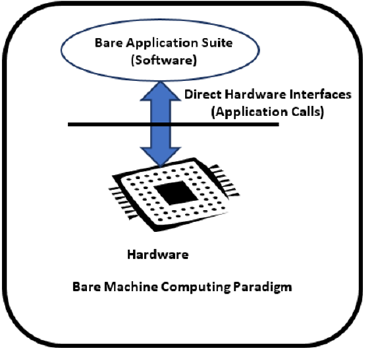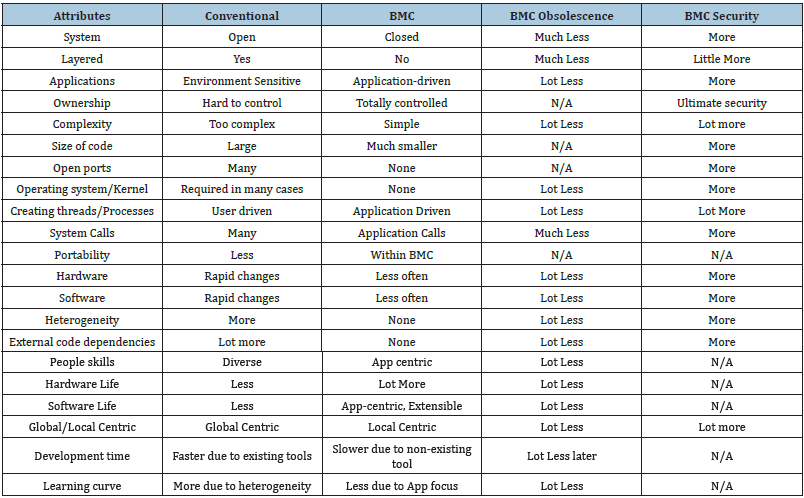- Submissions

Full Text
COJ Technical & Scientific Research
Bare Machine Computing Paradigm as an Ultimate Secure System
Ramesh K Karne*
Towson University, USA
*Corresponding author: Ramesh K Karne, Towson University, Towson, MD 21252, USA
Submission: July 30, 2021; Published: August 12, 2021

Volume3 Issue4August, 2021
Opinion
Computing trends have been following evolution and obsolescence, as cleared stated
by Bill Gates-Every product becomes obsolete in 3 years, “In three years, every product my
company makes will be obsolete. The only question is whether we will make them obsolete
or somebody else will.” In addition, complexity, open systems, layering, heterogeneity,
computing environments and improvements in technology further contribute to the speed
of obsolescence. Obsolescence has been studied over the years and found that it has many
dimensions and side effects. Most of the industry believes that the obsolescence is necessary
to make continuing profits, by making products obsolete. The obsolescence spans across
many disciplines and software and hardware products. Obsolescence is resulting in a jungle of
products with incompatibilities and no customer and product support within a short period
of time. Consequently, it results in retiring products before their useful life and incurring
waste of money, resources, people skills, security vulnerabilities and open doors for hackers.
The Bare Machine Computing (BMC) paradigm tries to address these issues and provides
an alternate solution to reduce obsolescence and inherent longevity in computing hardware
and software. An ultimate secure system can be built by using the BMC paradigm. The BMC
approach is a two-prong methodology. First, a computing device is bare, with no persistent
storage, no operating system and no hacker value. The device can’t perform anything unless a
given software is loaded with an external medium. Secondly, this is a different programming
paradigm. All programs are user application programs and controlled by the user. There are
no privileged programs or system programs. An application programmer designs a single or
a suite of applications as a single monolithic thread of execution to run on the bare device.
When this application suite is running, there is no other applications can be run at the same
time. The application program has direct hardware interfaces to manage, control and execute
a given application. A given application suite has an owner, no one else can run this application
without proper permit by the owner. This approach does not have any layers, no external
software dependency and no kernel to run the program. It is a non-layered closed systems and
only performs intended functions.
Using the BMC paradigm, numerous complex applications were developed, such as Web
servers, UDP servers and clients, Email servers, Email client, VoIP, Split protocol servers, text
only browsers, multicore servers, bare SQLite, bare file systems, routers, Gateways and so on.
The BMC research found many novel computing aspects while constructing many complex
bare machine applications. The result of building bare machine computing applications
provided a greater insight into building secure computer applications and systems. When
bare machine computing is adopted, its focus is in end user applications instead of computing
environments. When computing environments are eliminated, then a given application gains
longevity and there is no need to discard it anymore. It is a “green” friendly computing. It forces the hardware and software components to logically extend rather
than starting new designs. For example, a text processing is an end
user application, where as a Microsoft Word is an environment.
When a new feature is added to text processing, it should extend
the application rather than discard it. Upward compatibility must
be preserved in hardware and software to reduce obsolescence.
Majority of today’s security vulnerabilities are caused by operating
systems, open systems and layered architectures. When there are
hundreds of doors open in the operating system, how can you
expect a secure system? When six billion people have access to
the same Web, how can you achieve super security on the Web?
As you witness every week, some system has been hacked due to
some hole in the system somewhere! When they fix one hole, it
may open doors for other holes. The current computing system
architecture by design is not secure! This requires revisiting the
current computer architectures and IT infra-structure and develop
a super secure computing paradigm that is based on bare machine
computing and application centric models, instead of diverse
environments. As the current systems are very complex and large, it
is very difficult to study all aspects of security with heterogeneous
hardware and software components and design a super secure
systems. The following (Figure 1) shows the BMC paradigm, and
the (Table 1) illustrates the major differences of current computing
and BMC and its inherent security by design.
Figure 1: Bare machine computing paradigm.

Table 1: Comparing conventional computing vs bare machine computing.

© 2021 Ramesh K Karne. This is an open access article distributed under the terms of the Creative Commons Attribution License , which permits unrestricted use, distribution, and build upon your work non-commercially.
 a Creative Commons Attribution 4.0 International License. Based on a work at www.crimsonpublishers.com.
Best viewed in
a Creative Commons Attribution 4.0 International License. Based on a work at www.crimsonpublishers.com.
Best viewed in 







.jpg)






























 Editorial Board Registrations
Editorial Board Registrations Submit your Article
Submit your Article Refer a Friend
Refer a Friend Advertise With Us
Advertise With Us
.jpg)






.jpg)














.bmp)
.jpg)
.png)
.jpg)










.jpg)






.png)

.png)



.png)






